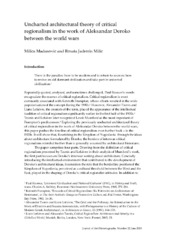Приказ основних података о документу
Uncharted Architectural Theory of Critical Regionalism in the Work of Aleksandar Deroko Between the World Wars
| dc.creator | Mađanović, Milica | |
| dc.creator | Jadrešin Milić, Renata | |
| dc.date.accessioned | 2022-07-13T07:55:17Z | |
| dc.date.available | 2022-07-13T07:55:17Z | |
| dc.date.issued | 2020 | |
| dc.identifier.issn | 2042-4752 | |
| dc.identifier.uri | http://rifdt.instifdt.bg.ac.rs/123456789/2667 | |
| dc.description.abstract | The concept of distance identifies the modern history of the Balkan Peninsula. From a point of geography, the Balkans is an area in Southeast Europe prevalently populated by Indo-European ethnic groups. Economically, politically and culturally, however, the region traditionally fluctuates between two different spheres of influences – the West (i.e. Central and Western Europe) and the East (i.e. Eastern Europe and Asia Minor). Distant from both, yet, unavoidably inextricable, the Balkans set the stage for unique interpretations, translations, and criticism of the imported creative impulses. This paper presents the "unchartered" territories of the Balkan architectural, examining an interwar criticism of the Modern Movement, formulated decades before Kenneth Frampton wrote his Critical Regionalism. Contemporary of Alvar Aalto, Yugoslav architect Aleksandar Deroko also had a unique reaction to the stifling uniformity of Modernism. Deroko developed his regionalist design theory learning from the vernacular. According to him, vernacular architecture was a response to region-specific functional imperatives, shaped for distinct geographical features. Deroko maintained that these highly functional structures, devoid of excess architectural ornament, should serve as architectural textbooks, firmly objecting to the Modernist insensitivity to the local conditions. The distance of the Balkans in a European context, and Deroko’s individualistic remoteness from the dominant architectural practices of the Kingdom of Yugoslavia resulted in an anonymity of his theory in the international historiographies of architecture. How did the distance of the Balkans from the European cultural centres – and, at the opposite end of the spectrum: the connections of the shared heritage – influence the shaping of Deroko’s unique architectural theory? Analysing Deroko’s ideas within the context of critical regionalism, this paper will demonstrate that Europe is even more diverse than typically assumed. | sr |
| dc.language.iso | en | sr |
| dc.publisher | The University of Birmingham | sr |
| dc.rights | openAccess | sr |
| dc.rights.uri | https://creativecommons.org/licenses/by/4.0/ | |
| dc.source | Journal of Art Historiography | sr |
| dc.subject | Interwar architecture | sr |
| dc.subject | the Balkans | sr |
| dc.subject | Aleksandar Deroko | sr |
| dc.subject | Critical Regionalism | sr |
| dc.title | Uncharted Architectural Theory of Critical Regionalism in the Work of Aleksandar Deroko Between the World Wars | sr |
| dc.type | article | sr |
| dc.rights.license | BY | sr |
| dc.citation.issue | 1 | |
| dc.citation.volume | 22 | |
| dc.type.version | publishedVersion | sr |
| dc.identifier.fulltext | http://rifdt.instifdt.bg.ac.rs/bitstream/id/9337/bitstream_9337.pdf | |
| dc.identifier.rcub | https://hdl.handle.net/21.15107/rcub_rifdt_2667 |

